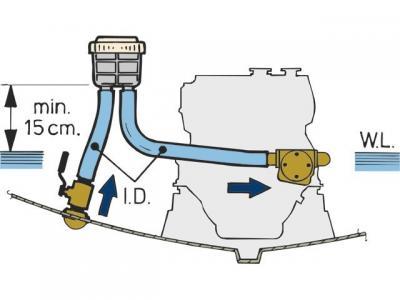
The difference between a wet and dry exhaust explained!
Compare a dry exhaust to the exhaust pipe of the car: a pipe with a flexible connecting piece on the exhaust manifold, discharging the exhaust gases directly to the outside air. A dry muffler is often required to muffle the noise. Cooling water from the engine is added to the exhaust system either externally or at a much later stage. The tubes and pipes are often made of steel to prevent them from melting due to the high temperature. It is a simple system, but with two major drawbacks: it emits intense heat of up to 600°C at the source, and it produces more noise.

Rather a wet exhaust?
What is a good alternative? That’s right, the much talked-about wet exhaust system. It is recognised by the manifold that is mounted on the engine. This is often custom-made from cast iron. It is also recognised by the freezer caps in the cooling channels. The heated cooling water in the engine is around 60-90°C when it leaves the engine, so it can be perfectly used to cool the 600°C exhaust gases. Water and gases are often not yet mixed in the first section of the exhaust pipe. That is to prevent the water from entering and blocking the gases from exiting the engine. Gases must be able to exit the engine smoothly so as not to compromise the engine performance. At a short distance from the engine, the gases and liquids come together and exit the engine.
The difference in temperature of a dry and wet exhaust is noticeable and has many advantages.
The noise of a wet exhaust is muffled by the water, but a rubber exhaust hose can also be used. This gives more flexibility and has a longer life span.
Various cooling systems
In simple terms, there are three types of cooling systems: 1. A system that pumps water straight from outside into the engine block by way of an impeller pump; 2. A separated system, often referred to as an intercooling / heat exchanger system, with coolant in the engine and an impeller pump pumping cooling water through a heat exchanger. 3. A keel cooling system, with cooling pipes containing coolant running underneath the boat. A wet exhaust is not possible in this system, unless an extra pump is installed.
From dry to wet? Convert the dry exhaust if you would like to experience the advantages of a wet exhaust system. Fully assembled exhaust pipes are available on the market. Or just add water to the dry exhaust, where only the first section is not cooled. Conversion may require a fair amount of money, but it is an easy job for the handy do-it-yourselfer and it will pay off in due course. 
( wet exhaust system with waterlock and muffler).
A wet exhaust consists of the following components from start to finish:
- A water inlet pipe underneath the boat with a shut-off valve to stop the supply during repairs or maintenance.
- A seaweed filter to stop harmful material entering the impeller pump.
- A suction pump on the engine (impeller or bilge water pump.
- When conversing from keel cooling to intercooling: a heat exchanger with water-cooled exhaust manifold.
- A water injection piece, which adds cooling water with an aerator past the exhaust manifold, to prevent the water from siphoning back into the engine when the engine stops.
Also, a so-called Waterlock is recommended when using a wet exhaust. A waterlock collects the water and pushes it upwards through the exhaust with the exhaust fumes by means of overpressure. A waterlock also muffles the noise, because it remains at water level. The gooseneck serves as an extra safety feature to prevent backflow of water when the engine is lower, as is the case in most sailboats. Installation of a muffler is still an extra option. A muffling and flexible exhaust hose can also be used for wet exhaust systems; it can be attached using stainless-steel hose clamps.
Looking for advice on your exhaust system? Please do not hesitate to contact us, or visit our website for various parts.
Go to our contact page












